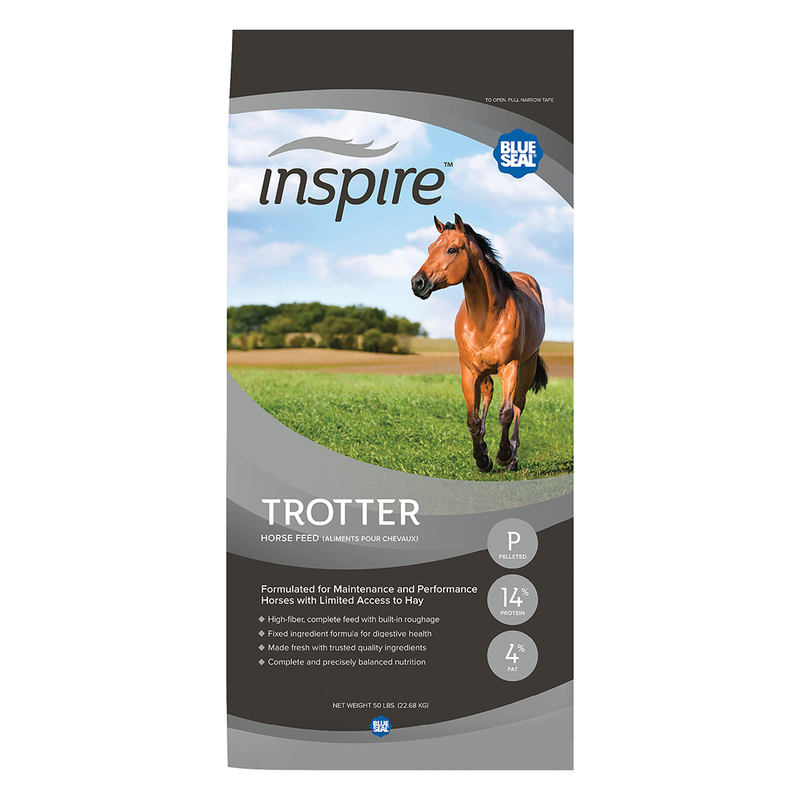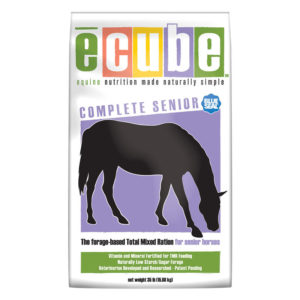Home > Horse Care > Nutrition > Running short on hay? 5 Forage Alternatives for Horses
Running short on hay? 5 Forage Alternatives for Horses
- July 13, 2020
- ⎯ Kent Nutrition Group
Long-stem forage is the most important part of a horse’s diet. Ideally, a horse should eat between 1.5 and 2% of its body weight in roughage or long stem forage each day because it helps buffer stomach acid and support a healthy hindgut. The amount of grain and forage a horse needs depends on their age, body condition and workload or activity level (talk to your veterinarian or equine nutritionist for recommendations). Physiological status is also important.
Quality pastures can provide as much as 50 – 90% of a horse’s daily nutritional needs. Extreme summer weather conditions including droughts and floods can put a crunch on pasture availability and hay supply. When pastures burnout and hay shortages arise, you need a plan for providing alternative sources of fiber.
Here are five options for supplementing your forage supply and/or forage quality.
Complete Feeds

Commercially manufactured “complete feeds” with high fiber are formulated to provide all the nutrition a horse needs when pasture or hay is unavailable or when senior horses, prematurely aging horses and horses with poor dentition cannot chew long-stem fiber or roughage sources. Ideally, we don’t want to replace hay or long-stem fiber from a horse’s diet, but some situations warrant it. These complete feeds can help to extend or stretch supplies and supplement poorer quality roughage sources. Older horses can receive all the calories, protein, fat, fiber, minerals and vitamins needed when fed according to the label instructions.
Beet Pulp
As a byproduct of the sugar beet industry, beet pulp is a highly digestible fiber source. It’s available in shredded and pelleted form. The highly digestible fibers contain 9-10% crude protein and is low in starch and sugar making it a safe choice for horses with metabolic conditions.
Soaking beet pulp may help prevent choke while also bringing water into the horse’s digestive system. It is a popular choice for weight gain, especially for horses with bad teeth. Beet pulp is high in calcium and shouldn’t be fed to horses with a history of kidney or urinary stones. There are several equine feed products available with beet pulp.
Hay Cubes
Often made with timothy, timothy/alfalfa or alfalfa varieties, hay cubes are a good source of fiber and protein. The tightly packed cubes can be given dry or soaked. Soaking the cubes for 10 to 15 minutes softens them but leaving them in water too long allows nutrients to leech out before the horse can consume them.

Because they are made from forages, they are a suitable substitute, but do not provide a completely balanced ration. There are some cube type products that are fortified and will provide vitamins and minerals. Be sure to read the label to see if the cube is purely hay based or if it includes vitamins and minerals at adequate levels. If the cube is strictly providing roughage, a vitamin and mineral supplement should be fed if the horse isn’t receiving adequate grain or concentrate along with the cubes.

Pelleted Fiber Products

There are a number of pelleted fiber/roughage products available for horses. These products typically have a nutritional profile similar to a good grass hay. In most cases, they are a fiber source and are not vitamin and mineral supplemented. They are not designed to replace 100% of the hay or pasture a horse would normally consume. In most cases, they can replace a portion the hay or pasture in a diet, refer to feeding directions for complete guidelines. A horse’s digestive system depends on long-stem fiber to function properly. These pelleted fiber products are a good option to stretch hay or pasture supplies and can also be a good option for horses who have trouble chewing long stem fiber sources.
Haylage
Common on dairy farms, haylage is gaining in popularity for horse owners. It is a grass and or legume that is cut prior to flowering or seed head formation. It is left to wilt rather than thoroughly dry and “cure” and is stored without oxygen in anaerobic conditions.
Haylage can be a nutritious forage source for horses, however, there is a risk of botulism and mycotoxin contamination if it is not cut, stored and preserved under ideal conditions. Horses fed haylage should be vaccinated for botulism for protection from these potentially deadly bacteria.
Spoiled haylage typically smells foul, is not palatable and may be black, brown, caramelized or charred-looking. Not all spoilage is easily visible so it must be checked carefully and haylage should never be fed to horses. It is usually recommended that haylage not make up more than 50% of the total amount of forage fed to horses.
Take it slow
Choosing which forage alternative is right for your horse depends on your location, management style and the individual horse. The most important thing to remember is that the horse’s digestive system is extremely sensitive. Abrupt diet changes can increase a horse’s risk for diarrhea or colic. Introduce new rations gradually, ideally over a two-week time span to give the horse’s system time to adjust.
Sponsored by: Kent Nutrition Group
To find a local dealer in the Midwest, visit kentfeeds.com and in the East visit, blueseal.com.





